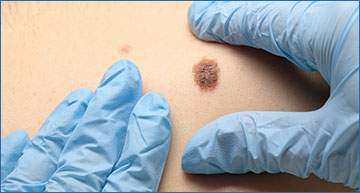UC Davis cancer researchers hope new technology will help diagnose and treat melanoma more successfully
A new UC Davis-led study sheds light on cell type-specific biomarkers, or signs, of melanoma. The research was recently published in the Journal of Investigative Dermatology.
Melanoma, the deadliest of the common skin cancers, is curable with early diagnosis and treatment. However, diagnosing melanoma clinically and under the microscope can be complicated by what are called melanocytic nevi—otherwise known as birth marks or moles that are non-cancerous. The development of melanoma is a multi-step process where “melanocytes,” or the cells in the skin that contain melanin, mutate and proliferate. Properly identifying melanoma at an early stage is critical for improved survival.
Microscopic image of melanocyte cells that produce skin and eye pigment
“The biomarkers of early melanoma evolution and their origin within the tumor and its microenvironment are a potential key to early diagnosis of melanoma,” said corresponding author of the study Maija Kiuru, associate professor of clinical dermatology and pathology at UC Davis Health. “To unravel the mystery, we used high-plex spatial RNA profiling to capture distinct gene expression patterns across cell types during melanoma development. This approach allows studying the expression of hundreds or thousands of genes without disrupting the native architecture of the tumor.”
Experimental design for spatially resolving mRNA biomarkers in FFPE samples from four pathologically defined tumor types
(a) Schematic of comparisons enabled by the experimental design (blue arrows). (b) Selected pathway content of 1,412 target (4,998 probes) gene panel for DSP with NGS readout. Panel content is approximately 35% immune related, 40% tumor-related, and 20% microenvironment related, with 1% housekeeping genes and 3% negative probes. (c) Schematic of probe design for DSP with NGS readout. Each probe contains an antisense sequence that hybridizes to target mRNA (green), a photocleavable linker (purple), an RNA ID that identifies the mRNA target (red), and a unique molecular identifier (blue) to allow removal of PCR duplicates when converting reads to digital counts. DSP probe pools target each gene with 1‒10 probes that hybridize to different sequences along the mRNA transcript and contain >80 negative probes that target scrambled or nonhuman sequences. (d) Workflow for DSP with NGS readout. Collected oligos are PCR amplified using indexing primers to preserve ROI identity, pooled, purified, and sequenced. (e) Illustration of ROI selection process. Top images: ROIs selected by a pathologist on the basis of enrichment for melanocytes, keratinocytes, or immune cells in H&E section. Bottom images: ROIs collected from a serial section during DSP. Fluorescent antibodies to melanocyte markers S100B and PMEL, T-cell marker CD3, lymphocyte marker CD45, and DNA stain SYTO 13 were used as visualization markers during DSP to guide the matching of ROIs to the H&E sections. Bar = 0.2 mm. CN, common nevus; CT, cancer/testis; DN, dysplastic nevus; DSP, Digital Spatial Profiler; ECM, extracellular matrix; EMT, epithelial to mesenchymal transition; FFPE, formalin-fixed, paraffin-embedded; ID, identifier; MIS, melanoma in situ; MM, invasive melanoma; NGS, next-generation sequencing; PI3K, phosphatidylinositol 3 kinase; ROI, region of interest; TLR, toll-like receptor; UMI, unique molecular identifier.
New technology used during study
The study examined the expression of over 1,000 genes in 134 regions of interest enriched for melanocytes, a cell in the skin and eyes that produces the pigment called melanin, as well as neighboring keratinocytes or immune cells. The tissue examined came from patient biopsies from 12 tumors, ranging from benign to malignant, using the NanoString GeoMx® Digital Spatial Profiler.
“We found that melanoma biomarkers are expressed by specific cell types, some by the tumor cells but others by neighboring cells in the so-called tumor microenvironment. The most striking observation was that S100A8, which is a known melanoma marker thought to be expressed by immune cells, was expressed by keratinocytes that make up the outermost layer of the skin called the epidermis,” said Kiuru. “Melanoma biomarkers in the epidermis have been largely overlooked in the past.”
Microscopic image of keratinocyte cells that produce outer layer of skin
Keratinocytes are epidermal cells that have multiple functions, including forming a barrier against micro-organisms, heat, water loss, and ultraviolet radiation. Normal keratinocytes also control the growth of melanocytes.
“Unexpectantly, we discovered that S100A8 is expressed by keratinocytes within the tumor microenvironment during melanoma growth,” said Kiuru. “We further looked at S100A8 expression in 252 benign and malignant melanocytic tumors, which showed prominent keratinocyte-derived S100A8 expression in melanoma but not in benign tumors. This suggests that S100A8 expression in the epidermis may be a readily detectable indicator of melanoma development.”
Many molecular tests for diagnosis and prognosis of melanoma are gradually being introduced but markers of early melanoma development, particularly in the tumor microenvironment, remain lacking. In addition, although the treatment of metastatic melanoma has changed drastically since the development of immune checkpoint inhibitor therapies, biomarkers predicting the duration a patient will be cancer-free are largely unknown. Previous research has utilized sophisticated methods, including single-cell RNA sequencing, but has largely focused on melanoma metastases, or secondary tumor growths. This has overlooked the keratinocyte microenvironment of primary melanomas.
Source – UC Davis
Kiuru M, Kriner MA, Wong S, Zhu G, Terrell JR, Li Q, Hoang M, Beechem J, McPherson JD. (2022) High-Plex Spatial RNA Profiling Reveals Cell Type‒Specific Biomarker Expression during Melanoma Development. J Invest Dermatol 142(5):1401-1412.e20. [article]







